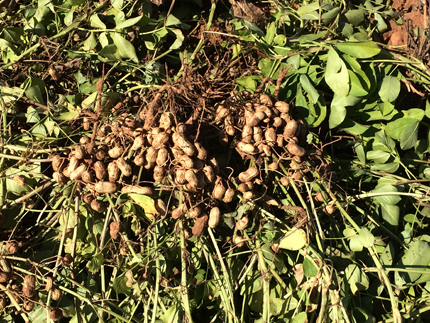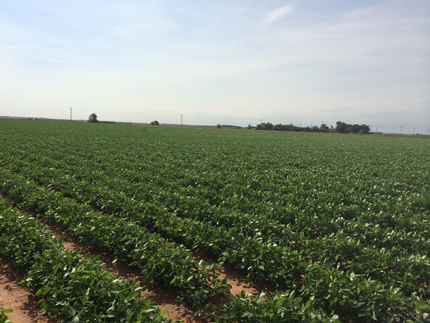5585 Guilford Road • Madison, WI 53711-5801 • 608-273-8080 • Fax 608-273-2021
www.agronomy.org
Twitter | Facebook
NEWS RELEASE
Contact: Hanna Jeske, Associate Director of Marketing and Brand Strategy, 608-268-3972, hjeske@sciencesocieties.org
Breeding a better peanut butter
July 16, 2015 - Peanuts are big – big business that is. According to the National Peanut Board, Americans spend about $800 million a year on peanut butter, and peanuts contribute more than $4 billion a year to the US economy.
A new variety of peanut, called OLé, has recently been released by a team of researchers at the United States Department of Agriculture – Agricultural Research Service (USDA-ARS) and their colleagues at Oklahoma State University.
 OLé peanuts have longer shelf lives and increased disease resistance compared to other peanut varieties, and pack high amounts of a heart-healthy fatty acid called oleic acid.
OLé peanuts have longer shelf lives and increased disease resistance compared to other peanut varieties, and pack high amounts of a heart-healthy fatty acid called oleic acid.
Kelly Chamberlin, a Research Biologist in the Wheat, Peanut and Other Field Crops Research Unit at the USDA-ARS and part of the team that developed the OLé peanut, anticipates this new variety will greatly benefit consumers, farmers and the peanut industry.
While high-oleic peanuts have been in cultivation for a number of years, recently seed stock contamination and other logistical issues had led to a shortage of high-oleic peanuts of the Spanish market-type. Spanish peanuts have a high oil content, which gives them a characteristic “nutty” flavor when roasted, and are used primarily to make peanut candy, salted peanuts and peanut butter.
“The peanut industry [found itself] in urgent need of a replacement high-oleic Spanish cultivar with acceptable seed size, yield and disease resistance package” says Chamberlin. The OLé peanut was developed to meet this pressing need.
OLé peanuts contain large amounts of oleic acid, which is a heart-healthy monounsaturated fatty acid. Consumption of oleic acid has been linked to several health benefits, including better heart health, decreases in blood pressure, and alleviation of some symptoms of type 2 diabetes.
The relatively high amounts of oleic acid, compared to another fatty acid called linoleic acid, in OLé peanuts increases their shelf life tremendously. Unsaturated fatty acids, like oleic and linoleic acid, contain one or more double bonds between carbon atoms. Fats can go rancid when these double bonds break down. Fewer double bonds in a fatty acid means a greater shelf life. Oleic acid has fewer double bonds compared to linoleic acid.
 “Basically what we are doing is changing the chemistry of the seed so the peanuts do not go rancid as rapidly,” says Chamberlin, “and that increases the shelf life of the peanut product by up to 10 times.”
“Basically what we are doing is changing the chemistry of the seed so the peanuts do not go rancid as rapidly,” says Chamberlin, “and that increases the shelf life of the peanut product by up to 10 times.”
The longer shelf life, health benefits and “nuttier” flavor of OLé peanuts make them very attractive to the peanut industry. Farmers can benefit from this interest.
“There is a big demand [from industry] for high-oleic peanuts and there is a premium paid at the buying point for them,” says Chamberlin. “That makes a big difference for the farmers and to their overall profits.”
The OLé variety also helps farmers and the environment by being significantly more resistant to diseases. Sclerotinia blight and pod rot are fungal, soil-borne diseases that can devastate peanut fields.
Farmers often spend significant amounts of money and time applying fungicides to try to protect peanut crops. “But growing a disease resistance variety, like the OLé, could save farmers up to $150/acre because they wouldn't have to use any chemicals” says Chamberlin, “and that's big savings.”
In fact, during field tests OLé plants were three times as resistant to Sclerotinia blight and about seven times as resistant to pod rot when compared to OLin, an older variety of Spanish peanut.
Although OLé peanuts have increased disease resistance, Chamberlin labels its yield per hectare as “acceptable.” She and her research team are now working on varieties that have higher yields, by at least a thousand pounds per acre. “We are always trying to improve on every characteristic,” says Chamberlin.
Read more about the characteristics of OLé peanuts in the Journal of Plant Registration.
Journal of Plant Registrations is the official registration publication of the Crop Science Society of America. JPR publishes cultivar, germplasm, parental line, genetic stock, and mapping population registrations, as well as articles characterizing accessions held within plant germplasm collection systems and descriptions of plant genetic materials.